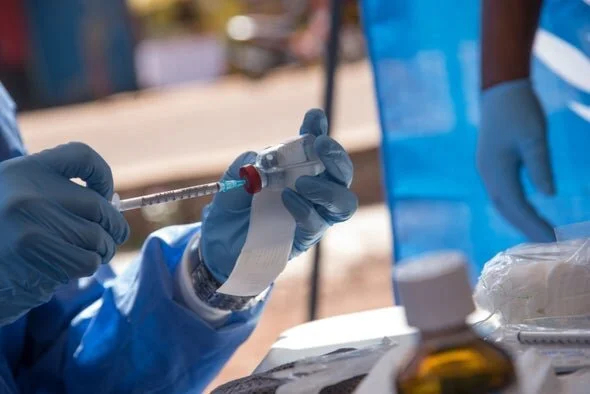Top 15 Science Discoveries of 2019
In the past decade, the world has been progressing at an alarmingly fast rate. Every year, we are discovering new things about the world around us. Just 20 years ago, we did not have the means nor the technology to know what we know today. These discoveries have not only uncovered many new and interesting things about our world but have also opened up an entirely new world of mysteries and wonders.
Here are the top 15 science discoveries of 2019:
Picture of a Black Hole
In April of this year, scientists took the first ever picture of a black hole. According to NASA, a black hole is, “a place in space where gravity pulls so much that even light can not get out. The gravity is so strong because matter has been squeezed into a tiny space. This can happen when a star is dying”. Up until now, black holes were a purely theoretical concept, even though scientists were very sure they existed. However, this picture proves that black holes really do exist! This black hole was discovered by the event horizon telescope and it is 55-million light years away!
Source: NASA
The anatomy of a black hole/ Source: NASA
Scientists discovered that Mars has earthquakes
California is not the only place that has major earthquakes! Scientists have recently discovered that Mars also gets seismic shaking. After sending a rover there in April, scientists have recorded more than 100 quakes coming from the red planet. This can definitely help scientists learn more about the planet and what it is like, on the inside and out!
Discovery of an (almost!) alien planet
In September, scientists detected water vapor in the atmosphere of a planet very far away, almost 124 light-years! Water can be a huge indicator of an alien life form and water is the basic object needed to sustain life anywhere. The planet was named K2-18b, and scientists call it a super-earth (because of its large size). A researcher stated that, “K2-18b is the only known planet outside our solar system with water, an atmosphere, and a temperature range that could support liquid water on its surface”. Even if there are not any alien life forms on the planet, it could potentially be used as a second home for the human race.
New Treatment for patients with Leukemia
Dr. Guy Sauvageau, a researcher at Université de Montréal's Institute for Research in Immunology and Cancer, has discovered a new treatment for leukemia patients that seems to be promising. Leukemia is also known as the cancer of the blood as it causes cancer in the blood-forming tissues of the body and decreases the body’s chance to fight off dangerous infections. Dr. Sauvageau found that Mubritinib, a drug originally meant for breast cancer patients, showed positive results in patients with leukemia.
Climate change and the rising oceans
Scientists predictions about rising oceans are starting to become far more accurate. Scientists estimated that the world’s oceans by 3 feet by the year 2100. This could put some islands and coastal cities underwater. This could also potentially displace up to 630 million people from their homes and cities.
Report by UN scientists show that between 500,000 - 1 million species could go extinct within a few decades
This report released by the UN claimed that up to 40% of amphibians, 33% of ocean and marine animals, and 10% of insect species are at risk of going extinct, largely due to actions by humans (such as littering, pollution, and climate change). They also found that 500,000 land animals do not even have enough natural habitat left to survive in the future. Many scientists think that we are currently experiencing the “sixth mass extinction”, with the fifth taking place over 65 million years ago.
Discovery of the giant squid
The giant squid has influenced many aspects of folklore and legends in Japan. This year, however, scientists were able to capture a picture of it in its natural habitat (catching food). This is a rare and interesting sighting because these giant squids, which can grow from 10 m to 13 m, almost never leave their home, which is 3,300 feet (1,000 meters) underneath the ocean surface. The picture was captured by Japanese scientists in the Ogasawara archipelago.
Source: Business Insider
Hidden continent discovered underneath Europe
Millions of years ago, Earth was not broken into the land masses that we now know today. It was all one big supercontinent called Pangea. Over time, as the tectonic plates shifted and broke into the continents we see today (North America, Europe, Africa, etc.). A new study has shown that an eighth continent, Greater Adria, slid under Europe 120 million years and helped form places like the Swiss Alps.
Image: © Douwe van Hinsbergen
Oldest skull ever of a human ancestor discovered
Scientists discovered the skull of a distant human relative that they believe is almost 4 million years old! The skull belongs to the species “Australopithecus anamensis”. The skull shows that these people had protruding foreheads and defined cheekbones. Scientists nicknamed this fossil MRD, and its age shows that it coexisted with other human variations.



Scientists discovered which person all modern humans come from
Using genetic testing, scientists have discovered a woman who lived in modern-day Botswana just south of the Zambezi River in Africa. Genetic analysis was done through the female line, and it is speculated that this woman lived around 200,000 years ago. This discovery supports the idea that all humans originate from the African continent (and then migrated to other parts of the world).
New Vaccine for Ebola released
This year, scientists developed and tested two new vaccines and treatments for the deadly Ebola disease. With the outbreak of the disease once more in the Democratic Republic of the Congo, it was declared a global health emergency by the World Health Organization. These two new vaccines saved about 90% of the infected people in the Congo.
Source: Scientific American
Cure discovered for X-linked severe combined immunodeficiency (XSCID) syndrome
XSCID, otherwise known as “bubble-boy” disease, is a genetic disease where babies do not have disease-fighting immune cells. This causes them to easily get sick wherever they go, and many times, they must be kept in isolation to prevent them from getting sick (a simple cold can be deadly for them). However, gene researchers at St. Jude’s Children Hospital were able to successfully cure the disease, giving a babies with XSCID a new chance at life.
The Saturnian Day
To this day, no scientists knew how long a full day on the planet Saturn lasted because there were no visible landmarks on the planet with which they could use to research this question. However, now by using Saturn’s rings, scientists have discovered that a full day on Saturn lasts 10 hours and 33 minutes.
3D printing Organs and Human Tissue
Scientists have figured out a way to 3D print organs and tissue that people may need. Although it is very much in the initial testing phases, this technology could be used to save millions of lives. If successful, people would not have to wait for months or years for organ transplants. This technology could also greatly help improve the quality of life for burn victims.
Source: NBC News
Google announces new supercomputer
Google claims that it has developed a “53-qubit processor” type computer that can perform a certain task in under 200 seconds that would otherwise take other supercomputers over 10,000 years to complete. This was developed in October.
Source: Silicon Angle
Vocabulary:
Theoretical: some that is calculated but not proven
Light-years: unit of length used to measure travel in space (1 LY = 6,000,000,000 miles)
Seismic Shaking: earthquakes and shaking ground
Rover: a type of robot that scientists send into space
Sustain: provide support for
Displace: being removed from a place
Folklore: legends and stories passed down through cultures or families
Tectonic Plates: a layer of rock underneath the earth’s surface, controls and causes earthquakes
Protruding Foreheads: foreheads that stick out
Coexisted: to live alongside/with in peace
Speculated: thought to be
ABOUT THE AUTHOR
Annik Brar is a student at the George Washington University in Washington, D.C. studying International Affairs and Psychology. In her free time, she manages a support page for people with Type 1 Diabetes. She also loves photography and traveling and can speak Punjabi and Hindi fluently!


















